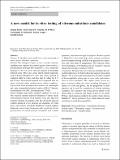| dc.contributor.author | Barth, Henrik | |
| dc.contributor.author | Crafoord, Sven | |
| dc.contributor.author | Ghosh, Fredrik | |
| dc.contributor.author | Langer, Robert S | |
| dc.contributor.author | O'Shea, Timothy Mark | |
| dc.contributor.author | Pritchard, Christopher David | |
| dc.date.accessioned | 2016-11-08T19:46:31Z | |
| dc.date.available | 2016-11-08T19:46:31Z | |
| dc.date.issued | 2014-07 | |
| dc.date.submitted | 2014-06 | |
| dc.identifier.issn | 0721-832X | |
| dc.identifier.issn | 1435-702X | |
| dc.identifier.uri | http://hdl.handle.net/1721.1/105267 | |
| dc.description.abstract | Purpose: To describe a new model for in vitro assessment of novel vitreous substitute candidates. Methods: The biological impact of three vitreous substitute candidates was explored in a retinal explant culture model; a polyalkylimide hydrogel (Bio-Alcamid®), a two component hydrogel of 20 wt.% poly (ethylene glycol) in phosphate buffered saline (PEG) and a cross-linked sodium hyaluronic acid hydrogel (Healaflow®). The gels where applied to explanted adult rat retinas and then kept in culture for 2, 5 and 10 days. Gel-exposed explants were compared with explants incubated under standard tissue culture conditions. Cryosections of the specimens were stained with hematoxylin and eosin, immunohistochemical markers (GFAP, Vimentin, Neurofilament 160, PKC, Rhodopsin) and TUNEL. Results: Explants kept under standard conditions as well as PEG-exposed explants displayed disruption of retinal layers with moderate pyknosis of all neurons. They also displayed moderate labeling of apoptotic cells. Bio-Alcamid®-exposed explants displayed severe thinning and disruption of retinal layers with massive cell death. Healaflow®-treated explants displayed normal retinal lamination with significantly better preservation of retinal neurons compared with control specimens, and almost no signs of apoptosis. Retinas exposed to Healaflow® and retinas kept under standard conditions showed variable labeling of GFAP with generally low expression and some areas of upregulation. PEG-exposed retinas showed increased GFAP labeling and Bio-Alcamid®-exposed retinas showed sparse labeling of GFAP.
Conclusions
Research into novel vitreous substitutes has important implications for both medical and surgical vitreoretinal disease. The in vitro model presented here provides a method of biocompatibility testing prior to more costly and cumbersome in vivo experiments. The explant culture system imposes reactions within the retina including disruption of layers, cell death and gliosis, and the progression of these reactions can be used for comparison of vitreous substitute candidates. Bio-Alcamid® had strong adverse effects on the retina which is consistent with results of prior in vivo trials. PEG gel elicits reactions similar to the control retinas whereas Healaflow® shows protection from culture-induced trauma indicating favorable biocompatibility. | en_US |
| dc.description.sponsorship | Swedish Research Council | en_US |
| dc.description.sponsorship | University of Lund. Medical Faculty | en_US |
| dc.description.sponsorship | Princess Margaret's Foundation for Blind Children | en_US |
| dc.description.sponsorship | Knut and Alice Wallenberg Foundation | en_US |
| dc.description.sponsorship | General Sir John Monash Foundation (Scholarship) | en_US |
| dc.description.sponsorship | In Vivo Therapeutics Corporation | en_US |
| dc.publisher | Springer Berlin Heidelberg | en_US |
| dc.relation.isversionof | http://dx.doi.org/10.1007/s00417-014-2714-3 | en_US |
| dc.rights | Creative Commons Attribution-Noncommercial-Share Alike | en_US |
| dc.rights.uri | http://creativecommons.org/licenses/by-nc-sa/4.0/ | en_US |
| dc.source | Springer Berlin Heidelberg | en_US |
| dc.title | A new model for in vitro testing of vitreous substitute candidates | en_US |
| dc.type | Article | en_US |
| dc.identifier.citation | Barth, Henrik et al. “A New Model for in Vitro Testing of Vitreous Substitute Candidates.” Graefe’s Archive for Clinical and Experimental Ophthalmology 252.10 (2014): 1581–1592. | en_US |
| dc.contributor.department | Massachusetts Institute of Technology. Institute for Medical Engineering & Science | en_US |
| dc.contributor.department | Harvard University--MIT Division of Health Sciences and Technology | en_US |
| dc.contributor.department | Massachusetts Institute of Technology. Department of Biological Engineering | en_US |
| dc.contributor.department | Massachusetts Institute of Technology. Department of Chemical Engineering | en_US |
| dc.contributor.mitauthor | Langer, Robert S | |
| dc.contributor.mitauthor | O'Shea, Timothy Mark | |
| dc.contributor.mitauthor | Pritchard, Christopher David | |
| dc.relation.journal | Graefe's Archive for Clinical and Experimental Ophthalmology | en_US |
| dc.eprint.version | Author's final manuscript | en_US |
| dc.type.uri | http://purl.org/eprint/type/JournalArticle | en_US |
| eprint.status | http://purl.org/eprint/status/PeerReviewed | en_US |
| dc.date.updated | 2016-08-18T15:26:59Z | |
| dc.language.rfc3066 | en | |
| dc.rights.holder | Springer-Verlag Berlin Heidelberg | |
| dspace.orderedauthors | Barth, Henrik; Crafoord, Sven; O’Shea, Timothy M.; Pritchard, Christopher D.; Langer, Robert; Ghosh, Fredrik | en_US |
| dspace.embargo.terms | N | en |
| dc.identifier.orcid | https://orcid.org/0000-0003-4255-0492 | |
| mit.license | OPEN_ACCESS_POLICY | en_US |
| mit.metadata.status | Complete | |
